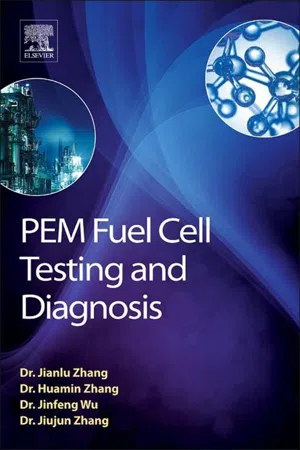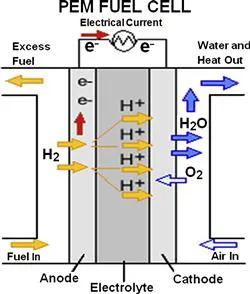
- 600 pages
- English
- ePUB (mobile friendly)
- Available on iOS & Android
PEM Fuel Cell Testing and Diagnosis
About This Book
PEM Fuel Cell Testing and Diagnosis covers the recent advances in PEM (proton exchange membrane) fuel cell systems, focusing on instruments and techniques for testing and diagnosis, and the application of diagnostic techniques in practical tests and operation. This book is a unique source of electrochemical techniques for researchers, scientists and engineers working in the area of fuel cells.
Proton exchange membrane fuel cells are currently considered the most promising clean energy-converting devices for stationary, transportation, and micro-power applications due to their high energy density, high efficiency, and environmental friendliness. To advance research and development of this emerging technology, testing and diagnosis are an essential combined step. This book aids those efforts, addressing effects of humidity, temperature and pressure on fuel cells, degradation and failure analysis, and design and assembly of MEAs, single cells and stacks.
- Provides fundamental and theoretical principles for PEM fuel cell testing and diagnosis.
- Comprehensive source for selecting techniques, experimental designs and data analysis
- Analyzes PEM fuel cell degradation and failure mechanisms, and suggests failure mitigation strategies
- Provides principles for selecting PEM fuel cell key materials to improve durability
Frequently asked questions
Information
1.1 Introduction

1.2 Electrochemical Reaction Thermodynamics in a H2/Air Fuel Cell
1.2.1 Thermodynamic Electrode Potential and Cell Voltage of a H2/Air Fuel Cell



Table of contents
- Cover image
- Title page
- Table of Contents
- Copyright
- Preface
- Biography
- Chapter 1. PEM Fuel Cell Fundamentals
- Chapter 2. Design and Fabrication of PEM Fuel Cell MEA, Single Cell, and Stack
- Chapter 3. Techniques for PEM Fuel Cell Testing and Diagnosis
- Chapter 4. The Effects of Temperature on PEM Fuel Cell Kinetics and Performance
- Chapter 5. Membrane/Ionomer Proton Conductivity Measurements
- Chapter 6. Hydrogen Crossover
- Chapter 7. Fuel Cell Open Circuit Voltage
- Chapter 8. Relative Humidity (RH) Effects on PEM Fuel Cells
- Chapter 9. Pressure Effects on PEM Fuel Cell Performance
- Chapter 10. High-Temperature PEM Fuel Cells
- Chapter 11. Fuel Cell Degradation and Failure Analysis
- Chapter 12. Electrochemical Half-Cells for Evaluating PEM Fuel Cell Catalysts and Catalyst Layers
- Acronyms and Abbreviations
- Index